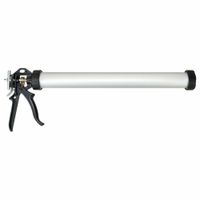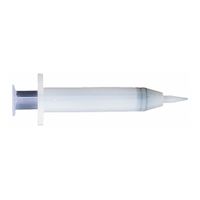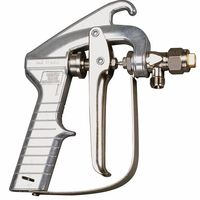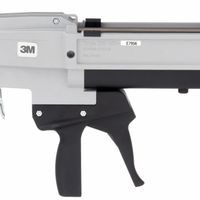Call +(254) 703 030 000 / 751 483 999 / 721 704 777
- Home
- Adhesives Sealants And Tape
- Adhesive Sealant Dispensing Equipment
.....Read More
Frequently Asked Questions
What are the different types of adhesive and sealant dispensing equipment?
Adhesive and sealant dispensing equipment encompasses a wide range of tools designed to apply materials precisely and efficiently. Manual options include caulk guns and syringes, ideal for small-scale applications or touch-ups, offering portability and ease of use. Pneumatic dispensers utilize compressed air to drive the material, providing consistent flow and reducing user fatigue, often seen in industrial settings for medium-volume tasks. Robotic dispensing systems offer the highest level of precision and automation, integrating with manufacturing lines for high-volume, repetitive applications, ensuring accuracy and speed. Additionally, specialized equipment exists for specific material types, such as hot melt applicators for solid adhesives, or two-part dispensers for materials requiring on-demand mixing. The choice of equipment depends on factors like material viscosity, application volume, desired precision, and production environment.
How do you refill adhesive and sealant dispensing equipment?
Refilling adhesive and sealant dispensing equipment typically involves several steps to ensure a smooth and efficient process while preventing contamination and air bubbles. First, ensure the equipment is clean and free of any residual material from previous uses. If the dispenser uses cartridges, carefully remove the old cartridge. For bulk dispensers, open the reservoir or container according to the manufacturer's instructions.
Next, prepare the new adhesive or sealant. If it's in a new cartridge, uncap it and trim the nozzle to the desired bead size. For bulk materials, ensure the container is clean and that the material is at the recommended temperature and viscosity for dispensing.
When refilling, always try to minimize air entrapment. For cartridges, simply insert the new cartridge into the dispenser, ensuring it clicks into place securely. For bulk systems, carefully pour or pump the material into the reservoir, avoiding vigorous agitation that could introduce air. Some advanced systems might have vacuum or pressure-assisted refilling mechanisms to prevent air bubbles.
Once refilled, prime the dispenser by extruding a small amount of material until it flows consistently and is free of air bubbles. This step is crucial for achieving an even and reliable application. Finally, clean any excess material from the equipment and store it properly according to the material's specifications to prevent curing or degradation. Regular cleaning and proper storage extend the life of your equipment and ensure optimal performance.
What are the benefits of using caulk gun applicators?
Using caulk gun applicators offers several benefits that streamline sealing and adhesive tasks. They provide precise control over the caulk flow, allowing for neat and consistent beads, which is crucial for achieving a professional finish and effective sealing. This precision minimizes waste and ensures that the material is applied exactly where needed. Caulk guns also make it easy to apply pressure, which is essential for forcing the caulk into gaps and cracks, ensuring a strong bond and a weather-tight seal.
Ergonomically, caulk guns reduce hand fatigue, especially during large or repetitive projects, as they distribute the force more efficiently than manual squeezing. This makes them suitable for extended use. Furthermore, many caulk guns accommodate various sizes and types of caulk tubes, making them versatile for different applications, from sealing windows and doors to bonding materials in construction. The ability to control the flow rate with a trigger mechanism allows users to adapt to different material viscosities and application speeds, contributing to greater efficiency and better results. Overall, caulk gun applicators enhance accuracy, efficiency, and comfort in sealing and bonding tasks.
How do two-part applicators and nozzles work?
Two-part applicators and nozzles are designed to mix and dispense two separate components, typically resins and hardeners, that react to form a cured material. These systems keep the components separate until the point of application to prevent premature curing.
The applicator, often a dispensing gun, holds two cartridges or syringes containing the individual components. When the trigger is squeezed, plungers advance simultaneously, pushing the components into a static mixing nozzle. Inside the nozzle, a series of helical elements or baffles divide and recombine the two streams repeatedly, ensuring thorough and homogeneous mixing without the need for external power or moving parts. The mixed material then exits the tip of the nozzle, ready for application.
This design is crucial for materials with short pot lives or those that require precise mixing ratios, as it ensures consistent and complete chemical reactions, leading to optimal material performance. Common applications include adhesives, sealants, and coatings in various industries.
What is the best way to maintain adhesive dispensing equipment?
Please specify what you would like to know about "What is the best way to maintain adhesive dispensing equipment?".
How do hot melt applicators function?
Hot melt applicators work by melting solid adhesive pellets or blocks into a liquid state and then dispensing the molten adhesive onto a substrate. The process typically involves a heating element that melts the adhesive, a pump or pressure system that forces the liquid adhesive through a hose, and a nozzle or gun that precisely applies the adhesive to the desired surface. As the molten adhesive cools, it solidifies, forming a strong bond between the materials.
What are the common issues with adhesive dispensing equipment and how to fix them?
Common issues with adhesive dispensing equipment include clogging, air bubbles, inconsistent flow, and improper curing. Clogging often occurs due to dried adhesive within the nozzle or lines; regular cleaning and using appropriate solvents can prevent this. Air bubbles can be introduced by improper mixing, worn seals, or low fluid levels, leading to voids in the dispensed adhesive; bleeding the system and inspecting seals can resolve this. Inconsistent flow might stem from pressure fluctuations, material viscosity changes, or worn components; maintaining consistent pressure, ensuring proper material temperature, and replacing worn parts are crucial. Improper curing can be caused by incorrect mix ratios, insufficient heat (for heat-cured adhesives), or expired material; verifying mix ratios, calibrating heating elements, and checking material shelf life are essential. Regular maintenance, proper material handling, and understanding the equipment's specifications are key to minimizing these issues and ensuring reliable adhesive dispensing.
How do you choose the right dispensing syringe or bottle for a specific application?
Choosing the right dispensing syringe or bottle depends on several factors, including the material to be dispensed, the required precision, the volume, and the application environment.
For materials like glues, sealants, or pastes, a syringe offers precise control. Considerations include viscosity (thicker materials require larger orifices), cure time (materials that cure quickly may need specialized tips to prevent clogging), and chemical compatibility with the syringe barrel and tip material. Syringes come in various sizes (e.g., 3cc to 60cc) and tip types (tapered, blunt, brush) to match different needs.
Bottles, on the other hand, are suitable for larger volumes or less precise applications, such as solvents, oils, or cleaning solutions. Factors to consider here include bottle material (e.g., HDPE, LDPE, PET for chemical resistance), closure type (e.g., screw cap, flip-top, Yorker for controlled dispensing), and nozzle design for the desired flow rate.
Environmental factors also play a role. For sterile or cleanroom applications, pre-sterilized and certified clean syringes or bottles are necessary. If the material is light-sensitive, opaque or amber-colored containers are preferred. Understanding these aspects ensures efficient and effective dispensing.
What safety precautions should be taken when using adhesive and sealant dispensing equipment?
When using adhesive and sealant dispensing equipment, several safety precautions are crucial to ensure operator well-being and prevent accidents. Always wear appropriate personal protective equipment (PPE), including safety glasses or goggles, gloves suitable for the chemicals being handled, and long-sleeved clothing to protect against splashes and skin contact. If working with volatile materials or in poorly ventilated areas, a respirator may be necessary.
Before operation, inspect the equipment for any damage, leaks, or loose connections. Ensure that all hoses, nozzles, and fittings are securely attached and in good condition. Verify that pressure gauges are functioning correctly and that the equipment's pressure limits are not exceeded.
During dispensing, maintain a stable and controlled working environment. Keep the work area clean and free of clutter to prevent trips or spills. Position the equipment and materials in a way that minimizes awkward postures or strain. Be mindful of potential pinch points or moving parts on automated systems.
After use, depressurize the equipment properly according to the manufacturer's instructions. Clean the equipment thoroughly to prevent material buildup, which can lead to clogs or malfunctions. Store adhesives and sealants in designated, well-ventilated areas, away from ignition sources and incompatible materials. Always refer to the specific material safety data sheets (MSDS) for the adhesives and sealants being used for detailed handling, storage, and emergency procedures. Regular maintenance and adherence to manufacturer guidelines for the dispensing equipment are also vital for safe and efficient operation.
How do spray applicators differ from other types of dispensing equipment?
Spray applicators differ from other dispensing equipment primarily in their method of product delivery and the resulting application characteristics. Other dispensing equipment, such as pumps, squeeze bottles, or droppers, typically deliver products as a stream, dollop, or individual drops. This often results in a more localized, targeted application.
In contrast, spray applicators atomize liquids into a fine mist or stream of droplets, distributing the product over a larger surface area. This method is ideal for achieving even coverage, quick drying times, or for applying products that need to be spread thinly, such as paints, deodorants, or cleaning solutions. The atomization can also create a more pleasant user experience for personal care products like fragrances or hairsprays. Furthermore, spray applicators often allow for touchless application, which can be more hygienic and efficient for certain uses. The specific type of spray (fine mist, coarse spray, continuous spray) can be tailored to the product and its intended use, offering greater versatility than many other dispensing methods.




